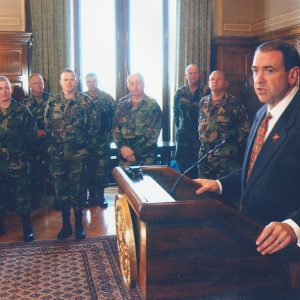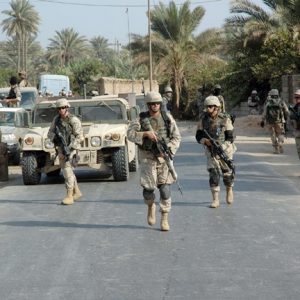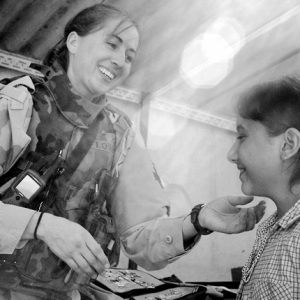calsfoundation@cals.org
Operation Iraqi Freedom
The armed conflict called Operation Iraqi Freedom began with an invasion of Iraq, led primarily by the United States with the assistance of Great Britain and other allies; the conflict lasted from 2003 to 2011. The invasion was initiated based on intelligence that Iraq possessed weapons of mass destruction (WMDs), and that Saddam Hussein was harboring and supporting al-Qaeda terrorists. The lack of evidence of any WMDs later became a political flashpoint. One goal of the invasion was to overthrow the oppressive regime of Saddam Hussein to establish a free and independent Iraqi government, democratically elected by its people.
Significant opposition arose in 2002–2003 during the run up to the war, with sixty-three percent of Americans desiring a diplomatic solution in Iraq. However, sixty percent of Americans supported military action if diplomatic efforts failed. In October 2002, when Congress passed a resolution authorizing military action, the six-person congressional delegation from Arkansas voted in favor, with a single dissenting vote, from Congressman Vic Snyder. Reminiscent of the Vietnam War era, protestors conducted numerous events across the nation. The largest consisted of between 100,000 and 400,000 held in New York City on February 15, 2003. As the invasion loomed, support for the war hinged on United Nations (UN) approval. A USA Today/CNN/Gallup poll showed that sixty percent of Americans supported military intervention as long as UN support was obtained. After the initial invasion in 2003, a majority of Americans supported military efforts. However, beginning in late 2004, public opinion shifted, declaring the invasion a mistake. By 2006, a majority of Americans felt that it was time for the coalition to get out of Iraq, although it was five years before this occurred.
The war’s first phase was a conventional-style war fought against the Iraqi military forces in March and April 2003, while the second phase was a protracted conflict against an opposing insurgency by occupying U.S. and coalition forces lasting from 2003 to 2011. Many Arkansans were deployed as part of regular military units, and the Arkansas National Guard deployed approximately 10,000 soldiers and airmen during the over eight-year war, resulting in twenty-three deaths of Guard members.
Back home, life continued uninterrupted by the war for most Americans. Unlike earlier conflicts, no rationing or major shortages impacted day-to-day activities. Although the war was covered extensively in the media for the first two or three years, coverage as well as public attention eventually waned. However, hometowns organized care packages for individuals, and school children sent packages, letters, and cards, especially around holidays. The biggest impact was on the families of the troops deployed, as well as their communities.
The Center of Military History established the following seven completed campaign phases for Operation Iraqi Freedom:
Phase 1: Liberation of Iraq, March 19, 2003–May 1, 2003
Phase 2: Transition of Iraq, May 2, 2003–June 28, 2004
Phase 3: Iraqi Governance, June 29, 2004–December 15, 2005
Phase 4: National Resolution, December 16, 2005–January 9, 2007
Phase 5: Iraqi Surge, January 10, 2007–December 31, 2008
Phase 6: Iraqi Sovereignty, January 1, 2009–August 31, 2010
Phase 7: Operation New Dawn, September 1, 2010–December 15, 2011
The invasion of Iraq began on March 19, 2003, with the “shock and awe” bombing campaign conducted by the United States and its coalition partners. This was followed by the U.S.-led invasion that rapidly defeated the military forces of Iraq, resulting in the collapse of Saddam Hussein’s government and forcing him into hiding. He was captured in December 2003 and executed in 2006 by the Iraqi government for crimes against his own citizens. Two units of the Arkansas National Guard were present during the initial invasion. The 296th Medical Company, Ground Ambulance from Charleston (Franklin County) provided combat medical evacuation support, while the 1123rd Truck Company from Blytheville (Mississippi County) provided logistical support in delivery of supplies for invading forces.
After the overthrow of Saddam Hussein, Iraq experienced major outbreaks of violence throughout the country. Much of this was sectarian violence between Sunni and Shia Muslims. Under Saddam Hussein, a Sunni, the minority Sunnis ruled harshly over the Shias. After Saddam Hussein’s defeat and execution, a power vacuum allowed Shias to exact reprisals for years of Sunni oppression. Additionally, the United States had not planned well for the follow-up operations after the war ended. The most difficult challenge for U.S. and coalition forces was to maintain order and security across Iraq, as they found themselves under increasing attacks from numerous insurgent groups within the country, primarily al-Qaeda, Fedayeen Saddam, and Shia cleric Muqtada al-Sadr’s Mahdi army, also known as Jaysh al-Mahdi (JAM).
In April 2004 the Arkansas National Guard deployed its largest unit, the Thirty-Ninth Infantry Brigade Combat Team (IBCT), consisting of over 3,000 soldiers. The Thirty-Ninth IBCT, assigned to the First Cavalry Division, spent the next twelve months stationed in Baghdad and surrounding areas. It was one of the first two National Guard brigades called to duty, along with another from North Carolina, and the first National Guard light infantry brigade deployed. During the year-long deployment, the Thirty-Ninth IBCT, stationed at Camp Cooke in Taji, Iraq, conducted full-spectrum combat operations. The First Cavalry Division reorganized its forces, resulting in the Thirty-Ninth IBCT’s First Battalion, 153rd Infantry being placed under control of Third Brigade, First Cavalry Division in the International Zone (or “Green Zone”), in Baghdad’s Karrada District. In return, the Thirty-Ninth IBCT received Second Squadron, Seventh Cavalry of the First Cavalry Division. After a year-long deployment of active combat, the brigade returned to Arkansas in April 2005; it had thirty-three soldiers killed, fifteen of whom were Arkansas National Guard members.
Operation Iraqi Freedom was unique in that it was the first time Americans at home had the opportunity to witness war in real time. National and local news media were embedded from the beginning of the invasion with troops as they entered Iraq, reporting daily on events and activities. On the homefront, the Arkansas brigade was featured almost daily in articles in the Arkansas Democrat-Gazette. An embedded journalist from the newspaper, Amy Schlesing, and a host of rotating photographers joined the Arkansas forces in 2004–2005 and again in 2008. They lived day-to-day life alongside the troops, sharing all the dangers and hardships. The articles and photographs allowed Arkansans to witness the war from the perspective of their own sons, daughters, husbands, and wives. The first deployment was also highlighted in a 2004 Discovery Times Channel documentary film titled Off to War. The ten-part series detailed daily activities, combat, and life in a war zone with two companies of Arkansas soldiers.
In June 2004, governance of Iraq returned to Iraqi control with plans to conduct the first-ever democratic elections. On January 30, 2005, parliamentary elections were held in order to begin the process of writing a new constitution. The elections were touted as the first free elections with inclusion of all groups in Iraq’s history. However, with the election of Nouri al-Maliki as prime minister, sectarian tensions increased, and the Sunni minority became increasingly alienated by the new government.
As U.S. and coalition casualties rose significantly in 2006, President George W. Bush desired to increase troop levels in an attempt to bring stability and peace. Although opposed by some in Congress, President Bush announced his plan to increase U.S. troop strength by over 20,000 personnel in January 2007, which became known as the “Surge.” Casualties increased drastically, making 2007 the deadliest year for U.S. forces, although levels of violence began to subside later that year.
The Arkansas National Guard’s Thirty-Ninth Infantry Brigade Combat Team deployed over 3,000 soldiers in January 2008 as part of the surge forces, assisting in the creation of a less violent Iraq. The Thirty-Ninth IBCT headquarters were placed in command of over 4,000 soldiers at Camp Liberty in Baghdad. Although most of its subordinate commands were placed under command of other active duty headquarters throughout Iraq, it maintained control over the First Battalion, 153rd Infantry Regiment. The First Battalion, 206th Field Artillery Regiment was responsible for base defense in Taji, Iraq. The Second Battalion, 153rd Infantry, stationed at Al Asad Airbase, provided security for convoys between Al Asad and the Syrian border. The First Squadron, 151st Cavalry Regiment conducted convoy security for long-haul resupply convoys from Tallil, Iraq, northward to Camp Liberty in Baghdad, as well as U.S. bases farther north in Taji and Balad. The brigade suffered two non-battle-related deaths during the ten-month deployment.
An agreement in late 2008 established new rules regarding U.S. military activity and established a timeframe for the eventual withdrawal of all U.S. forces. All U.S. forces withdrew from Iraqi cities in 2009, followed on August 19, 2010, by the departure of the last U.S. combat brigade, leaving only 52,000 U.S. troops stationed in Iraq. After Iraq became responsible for its own security and the role of U.S. forces was reduced, Operation Iraqi Freedom became Operation New Dawn on September 1, 2010.
On December 15, 2011, the U.S. military mission in Iraq officially ended with the lowering of the U.S. flag over Baghdad. The last U.S. troops crossed into Kuwait on December 18, 2011, ending over eight years of occupation by U.S. forces. The Arkansas Army National Guard’s Seventy-Seventh Aviation Brigade Headquarters was one of these last units to leave Iraq, in December.
Over 1.5 million U.S. service men and women, from all military branches, served during Operation Iraqi Freedom, incurring 4,424 deaths. In comparison, Great Britain, the primary coalition partner, sustained only 179 combat deaths during the over eight-year conflict. Although accurate numbers for Iraqi deaths are hard to ascertain due to a lack of Iraqi government figures and reporting prior to 2004, between 2004 and 2008, the Iraqi government estimates that over 85,000 Iraqis died. This included both military and civilian deaths. Total Iraqi deaths from 2003 to 2011 are considered to be well over 100,000, with conflicting reports as high as 650,000 over that same period.
Due to conflict with the terrorist organization ISIS in Iraq, a limited U.S. force returned to assist in the defeat of ISIS and the U.S. began considering sending more troops to assist in establishing stabilization and security.
Several monuments were built in Arkansas related to Operation Iraqi Freedom. Batesville (Independence County) and Bella Vista (Benton County) both have erected small memorials, while the largest is located at Camp Robinson in North Little Rock (Pulaski County).
For additional information:
39th Brigade Combat Team Historical Files. Arkansas National Guard Museum, Camp Robinson, North Little Rock, Arkansas.
Austin, Lloyd J. III. The Iraq War 2003–2011: Operation Iraqi Freedom 2003–Operation New Dawn 2011. Washington DC: 2012.
“Iraq by the Numbers.” Democratic Policy and Communication Center. https://dpc.senate.gov/docs/fs-112-1-36.pdf (accessed March 27, 2023).
“Iraqi Freedom 2003–2005.” Cavalry Out Post of the 1st Cavalry Division and Subordinate Commands. http://www.first-team.us/tableaux/chapt_19/ (accessed March 27, 2023).
McFadin, Daniel. “Solemn Anniversary Weighs on Vets.” Arkansas Democrat-Gazette, March 26, 2023, pp. 1A, 10A. Online at https://www.arkansasonline.com/news/2023/mar/26/20-years-after-the-iraq-war-arkansans-look-back/ (accessed March 27, 2023).
Munoz, Carlo. “Thousands of U.S. forces may still be needed for post-ISIS Iraq.” Washington Times, May 18, 2017. http://www.washingtontimes.com/news/2017/may/18/thousands-us-forces-may-still-be-needed-post-isis-/ (accessed March 27, 2023).
“Operation Iraqi Freedom (OIF) U.S. Casualty Status.” U.S. Department of Defense. https://www.defense.gov/casualty.pdf (accessed March 27, 2023).
Off to War. Directed by Brent and Chris Renaud. Discovery Times Channel, 2004.
Schlesing, Amy. The Bowie Brigade: Arkansas National Guard’s 39th Infantry Brigade in Iraq. Little Rock: Arkansas Democrat-Gazette, 2005.
Anthony Rushing
Benton, Arkansas
 Divergent Prosperity and the Arc of Reform, 1968–2022
Divergent Prosperity and the Arc of Reform, 1968–2022 Military
Military 39th Brigade
39th Brigade  Arkansas National Guard Memorial
Arkansas National Guard Memorial  Arkansas National Guard In Iraq
Arkansas National Guard In Iraq  Arkansas National Guard in Iraq
Arkansas National Guard in Iraq 



Comments
No comments on this entry yet.